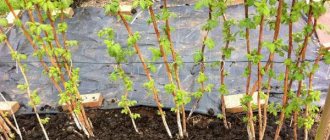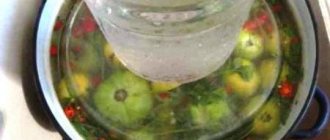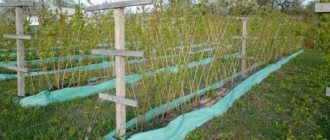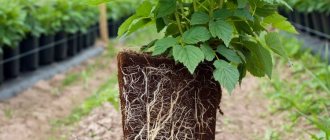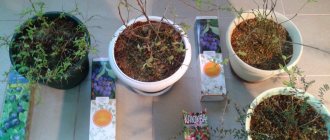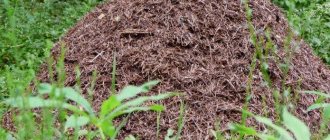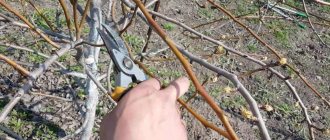One of the differences between remontant raspberries and regular ones is the weak formation of root suckers. There is practically no growth or there is little of it. Replacement shoots usually grow from 5 to 7, all of which are needed to obtain a harvest. However, raspberries remain the same crop. And although propagation by shoots is the simplest and most common way for it, there are others.
- 2 Reproduction by “nettles”
- 3 Green cuttings
3.1 Video: rooting cuttings taken from different varieties and from different parts of the plant
- 4.1 Video: propagation by lignified cuttings obtained as a result of autumn pruning
- 6.1 Photo gallery: what raspberry root cuttings look like
- 7.1 Video: propagation by horizontal layering using the example of ordinary (non-remontant) raspberries
Assortment of raspberry propagation methods
Modern gardeners have already tried many methods of propagating remontant raspberries: green and lignified cuttings, horizontal layering, part of the rhizome, dividing the bush, “nettle”. However, for each case you need to select your own effective option. For example, there are varieties whose cuttings root very poorly. It is better to propagate old, overgrown plants by dividing the bush. Planting material in the form of a part of a root with an adventitious bud can be separated from a newly purchased seedling. The method of propagating your raspberries depends on many factors: the age of the bush, variety, propagation season, the ability to create special conditions for rooting, etc.
This is a shoot of ordinary raspberries, the remontant one does not produce it, which is why difficulties arise with its propagation
Reproduction by "nettle"
For rooting, young plants that have just emerged from the ground in the spring are taken. At this stage, raspberries closely resemble young nettles. Shoots should be no more than 10 cm in height and have two well-developed leaves .
Raspberry shoots, just emerging from the ground, strongly resemble young nettles
What should be done:
- Rake the soil from the base of the shoot and cut it off with a white underground part; its length can reach 3–5 cm.
Planting material consists of an above-ground green part and an underground white part - Treat the cut with a root formation stimulator (Kornevin, Heteroauxin, Epin, etc.).
- Prepare a loose substrate of peat and sand (1:1) or peat, turf soil and sand (1:1:0.5).
- Plant the plant in a moist substrate. The entire white part and another 1 cm of green should be in the ground.
Root “nettle” in the garden bed or in cups
- Provide a greenhouse effect: cover with a jar, half a bottle, film, etc. On an industrial scale, rooting takes place in greenhouses with fog-forming units. At this stage, the plant has no roots and cannot feed from the ground, so it is important that drops of condensation fall on the leaves and do not allow them to dry out.
The greenhouse effect can be created using plastic bottles
If you are rooting shoots in the garden, then place greenhouses made of arcs and film in the shade of trees, bushes, and a fence. In the sun, under the film, the plants will cook. Optimal temperature for rooting: +20… +26 ⁰C. After about a month, you can judge the results. The young offspring will begin to grow, become taller, and new leaves will appear on them.
For rooting in open ground, build a mini-greenhouse
Green cuttings
In this way, gardeners root the side branches growing on the main stem and the stems themselves, cutting them into pieces with 2-3 internodes. There is experience in rooting even the tops left after pinching too tall shoots. But the likelihood that they will take root is very small. So, an Amur gardener managed to root one out of 8 tops. But this is also a result that pleases.
Video: rooting cuttings taken from different varieties and from different parts of the plant
Rules for preparing planting material:
- Cut green cuttings in June-July, when the shoots of remontant raspberries have already grown, but have not yet bloomed.
- When rooting lateral fruit branches, remove the growing point (apex), as well as the buds, if they are already present.
- Each cutting should have a minimum of 2 leaves, a maximum of 3–5. The fewer leaves, the less moisture they evaporate, but they cannot be removed completely, since it is in the leaves that photosynthesis occurs, which is necessary for plant nutrition.
- Make the bottom cut at an acute angle and not parallel to the petiole of the bottom leaf.
- Remove the bottom sheet.
- Treat the cuttings with a root formation stimulator and plant them in a loose substrate, immersing the area where the lower leaf grows by 1 cm.
The green cutting should consist of 2–5 leaves, the growing point (tip) must be removed
The rooting itself occurs, as in the case of “nettle,” in the same greenhouse conditions . On rooted cuttings, shoots should grow from the axils of the leaves, and they can also appear from the ground.
Pros and cons of the variety
The strengths and weaknesses of remontant raspberry varieties are presented in the table.
| pros | Minuses |
| Early fruiting. Raspberries planted in spring will produce their first harvest in the fall of the same year. | The harvest ripens later than regular summer raspberries. If all the stems were cut off for the winter, then next year the remontant will need time to build up green mass. The berries ripen by autumn, which is not convenient for all regions |
| Higher winter hardiness in contrast to summer raspberries. When cutting the stems completely, only the root part needs to be protected, which makes caring for the crop much easier | High requirements for food, lighting, heat, watering |
| Harvest stability. Constant pruning of shoots reduces the risk of them being affected by diseases, pests, and freezing. A harvest is guaranteed to be formed on young healthy shoots (if the plant has enough nutrition, heat and moisture) | Instability of taste and size of berries. If raspberries do not receive enough necessary nutrients, they will react sharply to this by deteriorating taste and reducing the size of the berries. At the same time, there are stable varieties (Karamelka, Atlant), and selection work is also underway |
Remontant raspberries, despite their shortcomings, are very interesting in gardening, like the Logan berry. It is necessary to choose it for planting on a personal plot under the condition of soil fertility, good lighting, and also if harvesting is possible in the fall.
Remontant raspberries should be planted only in fertile soil.
Rooting with lignified cuttings
Planting material is prepared in the fall, in October-November. Take annual fruit-bearing shoots as raw materials . By the end of the season they are already covered with wood. Cut them into cuttings according to the same rules as green ones. Only this time you need to remove all the leaves, if there are any left. After all, the growing season is over, the buds have formed, from which young leaves will appear next spring.
Autumn cuttings, instead of leaves, should have well-developed buds
Next, you can choose one of the methods or experiment with both at once:
- Planting in spring after winter storage. In the fall, tie the harvested cuttings into bunches and label them with the names of the varieties. Place in boxes and cover with damp sawdust or sand. Another option is to wrap it in a damp cloth and then in plastic, piercing it in several places for ventilation. Store in a basement, refrigerator or other place at a temperature of -2... +2 ⁰C and a humidity of 65–70%. In March, start rooting on a windowsill, in a greenhouse or greenhouse using the technology for green cuttings and “nettles”.
- Planting in the fall, immediately after cutting them. Plant the cuttings in a bed with loose soil, deepening them so that only two buds remain on the surface. Cover for the winter in the usual way for your region: spruce branches, reeds, agrofibre, etc. The material must be breathable, so do not use film or similar materials.
Lignified cuttings, their planting scheme
Skeptics claim that this is the most unreliable way to propagate raspberries. Even if leaves appear from the buds in the spring, this does not mean that the cuttings have taken root. The buds bloom due to the vital forces remaining inside the cuttings. However, enthusiasts do not refuse this method, because in the fall after pruning there are a lot of shoots that are thrown away or burned. Why not try rooting? There are positive results: out of 10 cuttings, 2–3 turn into seedlings.
Video: propagation by lignified cuttings obtained as a result of autumn pruning
Dividing the bush
The method is very similar to propagation by shoots. The only difference is that the replacement shoots of remontant raspberries are located very close to each other, they need to be dug out extremely carefully. Start this type of propagation in the spring, when the young shoots have grown no higher than 15–20 cm. Usually, 5–7 shoots are left in the bush for fruiting, and the excess ones are cut out. Find a well-grown bush in which such shoots are located away from the rest so that they can be separated with a shovel.
Recent Entries
Lilac perennials that are beautiful, compact and do not crowd out other plants Why when buying seedlings you should not take the sellers’ word for it and how to determine the age of the plant using 3 signs Tomato seedlings have turned purple or whitish: why the color has changed and how to save the plants
How to separate root suckers from a bush:
- Water the plant well, then the earth will not crumble and the seedlings can be dug up with a clod of earth.
- Stick a shovel between the mother bush and the shoot that you want to separate, deepen it to the full bayonet.
If there are more shoots in the bush than needed, use the outer ones for propagation
- Make such digs on all sides of the shoot and carefully pull out the roots without shaking off the soil from them.
- Plant the seedling in a permanent place.
If the stems grow close to each other, then you can use another method:
- Dig up the entire bush.
- Shake off the soil.
To better understand the intertwining of the roots, you can lower them into a basin of water and, after rinsing, carefully untangle them.
- Then divide the whole plant into parts with a sharp knife, so that each has 2-3 stems with roots.
You can divide the bush into several sections
- Plant the resulting seedlings in prepared planting holes.
Keep in mind that with this method you risk losing the variety if you divide the only bush you have. It may happen that not a single section will take root. Use this method if you have other raspberry bushes that you want to propagate.
Preparing a site for planting seedlings
For planting raspberry seedlings, you should choose well-lit areas that are not low, with stagnant water, or wetlands. But they also need to be prepared.
Planting holes or trenches should be spaced about 2 m apart and plants should be planted about 0.75 m apart
It is advisable to fill trenches or holes with a mixture of compost and wood ash
Plants are planted in such a way that the root collar is level with the ground.
After planting the cuttings, watering and mulching are carried out, and, if necessary, shading in the first few days.
Propagation by root cuttings
Raspberries have a fibrous root system; it consists of many roots, and on them there are dormant adventitious buds. They wake up and give off young shoots. This happens when old stems die and need to be replaced with new ones. This feature is used to propagate raspberries. If a root or part of a root is separated from the plant, adventitious buds spring up to compensate for the lack of shoots.
Where can I get root cuttings:
- cut from a seedling with a well-developed root system;
- cut from a growing bush, carefully digging out the ground underneath it;
- buy from breeders, order online.
There are no standards for this planting material. The maximum size is at least the entire root from the bush, the minimum is 8–10 cm, and you may not find any adventitious buds; in a dormant state they are very small and painted the same color as the root.
Photo gallery: what raspberry root cuttings look like
If the root against the background of the seedling seems large to you, cut off part of it and plant separately
The minimum size of the root cutting is 8–10 cm
Selling raspberry roots is now a profitable business; you can order such planting material on the Internet
Dormant buds woke up and started to shoot
This is the simplest and most effective method of reproduction, compared to those already described . Procedure:
- Prepare a loose and fertile substrate by mixing peat, turf soil and humus in equal proportions.
- Pour the resulting mixture into a box or pots, containers, so that there is still 5 cm left to the edges. Select the container according to the size of the cuttings, which will need to be located horizontally in it. You can plant them directly in the garden beds.
- Water the substrate and place the cuttings on top of it.
Place root cuttings horizontally
- Cover the top with loose soil in a layer of 2–3 cm.
- Keep on the windowsill or in the open ground, depending on the season. The optimal temperature is +18… +26 ⁰C . Water the soil as it dries. You can cover it with film or glass, but this is not necessary.
- When young shoots 5–7 cm high appear, dig up the resulting seedling and transplant it to a permanent place. If 2-3 shoots have grown on the cutting, each with roots, you can cut the common root into pieces . Sometimes such shoots are easily separated from the old root, along with their roots.
This method is often combined with propagation by nettles. But this requires a large fibrous root. It is used entirely: spread horizontally over the surface of a bed or large box and covered with earth. As the shoots grow, they are cut off with the white part and planted for rooting. On a root that has lost its shoots, more and more new buds will appear.
Video: combined method of propagation: root cuttings and “nettles”
Brief description of cultivation
- Landing . At the beginning of the spring period or in the last days of September or the first days of October.
- Illumination . Lots of bright sunshine.
- Soil . Light loamy fertile soil rich in nutrients is suitable. The optimal pH is 5.8–6.7. If possible, it is recommended to select an area after the black steam. The occurrence of groundwater must be at a depth of at least 100 cm.
- Watering . Systematically and abundantly approximately once every 7 days. However, in dry times the procedure is carried out more often. The soil in the raspberry garden should always be slightly moist. During watering, the ground should be saturated with moisture to a depth of 0.3 to 0.4 m. Shortly before flowering, as well as during the growth and ripening of berries, watering must be timely. Pre-winter watering occurs in October and should be very abundant. The drip irrigation method is excellent for raspberries.
- Fertilizer . If the seedlings were planted in fertilized soil, then fertilizing is not carried out for 2 years. Then the plants are fed every year. Organic fertilizer is best suited, for example, a solution of chicken manure (1:20) or fermented mullein (1:10). However, if the plantings are mulched with humus or compost, then organic fertilizers do not need to be used. Superphosphate is applied only during planting of seedlings. Bushes need regular fertilizing with potassium (without chlorine).
- Trimming . In the spring months, during the swelling of the buds, sanitary pruning is carried out. At this time, the root shoots are also removed. When fruiting is over, all stems are pruned. In spring, healthy young stems will appear that can bear fruit.
- Reproduction . Green cuttings and root shoots of plants 4–5 years old (but only if the variety produces them).
- Pests . Aphids, raspberry mites, raspberry beetles, spider mites and caterpillars.
- Diseases . Anthracnose, verticillium (wilt), curl, mosaic, didimella (purple spot), septoria, root canker (root goiter), bushy dwarf and infectious chlorosis.
Remontant raspberry. Features of planting and care
Reproduction by horizontal layering
The implementation of this method on ordinary raspberries begins in early spring. Annual overwintered shoots are bent to the ground. However, in most cases, remontant raspberries are mowed completely in the fall, so there is nothing to bend down and root in the spring. In autumn, annual shoots are covered with ripening berries. You will have to cut off all the fruit branches with them and leave the bare stem. This will become very stressful. The shoot, instead of rooting, may die.
This means that to propagate remontant raspberries by horizontal layering, you need to let the selected annual shoots overwinter and root them, like regular raspberries, in the spring. Another option is to conduct an experiment in the summer with a young shoot that has already grown, but has not bloomed. Once green cuttings take root, they can form roots and a whole shoot. In any case, choose horizontal layering according to the following criteria:
- It is located on the north side of the raspberry forest, in the shade. In the sun, the soil will quickly dry out, the leaves will wither, the roots will not appear or will be weak.
- The stem is powerful, but flexible, bends well and lies on the ground.
- There are side branches that, after laying the stem on the ground, will be directed upward.
Choose a strong but flexible shoot, preferably with side branches pointing upward
How to dig a raspberry shoot for rooting:
- Bend the shoot down, but don't secure it yet. Just try it on and make marks on the ground where it will be located.
- Prepare the marked area: loosen the soil, add peat and sand, mix.
- Make a groove 10–15 cm deep for laying the shoot. Fill it with water and let it soak.
- Bend the shoot and cut off all the side branches and leaves that rest on the ground or are directed to the side. Leave only those that will grow upward.
- At the base of each remaining branch, scratch the stem, making oblique or longitudinal cuts up to 2 mm deep. You can powder these places with Kornevin powder.
- Now place the shoot in the groove, pin it with wire staples and cover it with soil. At the same time, do not cover the leaves remaining on the stem and side branches; they should be above the soil. Also leave the top of the shoot, about 20 cm long, outside, point it vertically and tie it to a peg.
- Cover the digging area with mulch and keep the soil moist at all times.
If the shoot is laid in the spring, then the seedlings can be dug up, separated from the common stem and replanted in the fall . When rooting green shoots in summer, it is better not to disturb the plant until next autumn.
Video: propagation by horizontal layering using the example of ordinary (non-remontant) raspberries
There are many ways to propagate raspberries. Almost everything is dedicated to a specific season. In summer, use green cuttings, in spring propagate by “nettles” and dividing the bush, in autumn and spring - by rooting woody shoots, in summer and autumn - by horizontal layering. The easiest one is to grow raspberries from pieces of roots. We throw away a lot of planting material after pruning, but all this can become new plants. It is interesting to try each method and choose the most acceptable and effective one for your variety and style of farming.
- Author: Marina Volkova
I live in Siberia. I have my own house and my own plot) In the articles I share my experience, I learn something myself together with you) Rate the article:
- 5
- 4
- 3
- 2
- 1
(7 votes, average: 5 out of 5)
Share with your friends!
Care after planting and preparation for winter
Subsequent care for remontant raspberries consists of regular watering and updating the mulch. In the fall, you can cut off all annual shoots, but the next season's harvest will only be harvested once.
Most varieties of remontant raspberries tolerate winter cold well. It is not necessary to cover the trimmed raspberry tree, but it is worth mulching it with a thick layer of manure.
In regions with severe frosts, dry leaves or hay are placed on the mulch. To protect from the wind, install a fence from scrap materials.
Mulching with hay will protect the soil and root system of raspberries from frost.
If pruning has not been carried out, then the stems are bent to the ground, pressed with a board and covered with hay or leaves, and spruce branches are laid on top.
